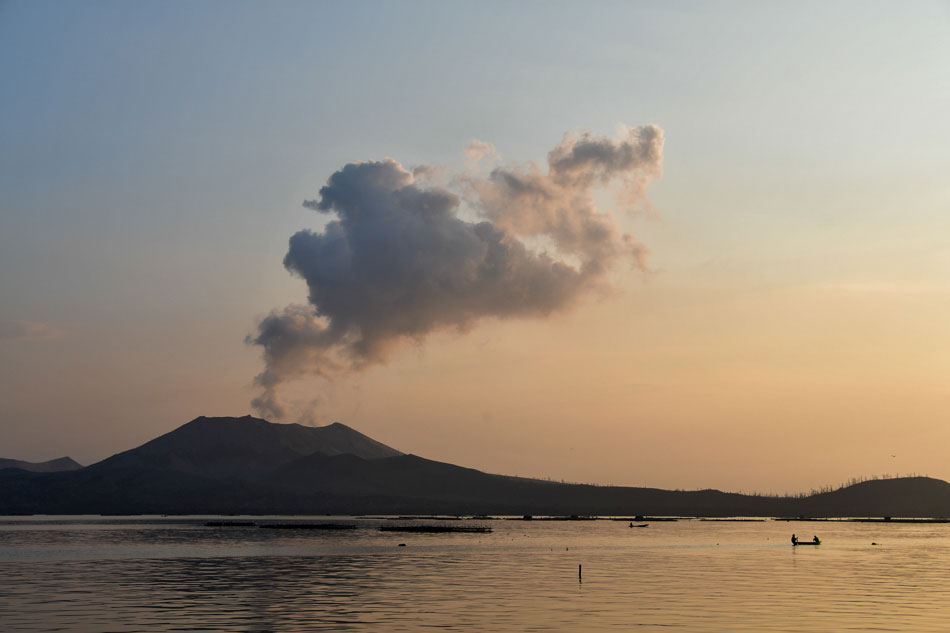Taal Volcano emits plumes; new earthquakes 'signify magmatic activity:' Phivolcs | ABS-CBN

Welcome, Kapamilya! We use cookies to improve your browsing experience. Continuing to use this site means you agree to our use of cookies. Tell me more!
Taal Volcano emits plumes; new earthquakes 'signify magmatic activity:' Phivolcs
Taal Volcano emits plumes; new earthquakes 'signify magmatic activity:' Phivolcs
ABS-CBN News
Published Feb 03, 2020 09:24 AM PHT
MANILA - State seismologists on Monday said Taal Volcano emitted dirty-white to white steam-laden plumes, and volcanic earthquakes were recorded indicating "magmatic activity" that might lead to eruption.
MANILA - State seismologists on Monday said Taal Volcano emitted dirty-white to white steam-laden plumes, and volcanic earthquakes were recorded indicating "magmatic activity" that might lead to eruption.
In its 8:00 am bulletin, the Philippine Institute of Volcanology and Seismology (Phivolcs) said its seismic monitoring network recorded at least 134 volcanic earthquakes since Sunday, which signified "magmatic activity beneath the Taal edifice that could lead to eruptive activity at the Main Crater."
In its 8:00 am bulletin, the Philippine Institute of Volcanology and Seismology (Phivolcs) said its seismic monitoring network recorded at least 134 volcanic earthquakes since Sunday, which signified "magmatic activity beneath the Taal edifice that could lead to eruptive activity at the Main Crater."
Philvolcs highlighted two seismic events, 4:20 am and 5:42 am which registered "respectively at magnitude 3.2 and 2.3, the first having been felt at Intensity IV in Laurel and Agoncillo and Intensity III in Lemery, Batangas."
Philvolcs highlighted two seismic events, 4:20 am and 5:42 am which registered "respectively at magnitude 3.2 and 2.3, the first having been felt at Intensity IV in Laurel and Agoncillo and Intensity III in Lemery, Batangas."
Taal Volcano also emitted "voluminous" plumes rising 800 meters high, with sulfur dioxide (SO2) emission recorded at an average of 97 tonnes/day on February 1, Phivolcs added.
Taal Volcano also emitted "voluminous" plumes rising 800 meters high, with sulfur dioxide (SO2) emission recorded at an average of 97 tonnes/day on February 1, Phivolcs added.
ADVERTISEMENT
Alert Level 3 remains, and "entry into the Taal Volcano Island as well as into areas over Taal Lake and communities west of the island within a 7-kilometer radius from the Main Crater must be strictly prohibited."
Alert Level 3 remains, and "entry into the Taal Volcano Island as well as into areas over Taal Lake and communities west of the island within a 7-kilometer radius from the Main Crater must be strictly prohibited."
Phivolcs also warned against likely "steam-driven and even weak phreatomagmatic explosions, volcanic earthquakes, ashfall, and lethal volcanic gas expulsions" within Taal Volcano Island and nearby lakeshores.
Phivolcs also warned against likely "steam-driven and even weak phreatomagmatic explosions, volcanic earthquakes, ashfall, and lethal volcanic gas expulsions" within Taal Volcano Island and nearby lakeshores.
Phivolcs also advised pilots not to fly close to the volcano, as "airborne ash and ballistic fragments from sudden explosions and wind-remobilized ash may pose hazards to aircraft."
Phivolcs also advised pilots not to fly close to the volcano, as "airborne ash and ballistic fragments from sudden explosions and wind-remobilized ash may pose hazards to aircraft."
ADVERTISEMENT
ADVERTISEMENT


